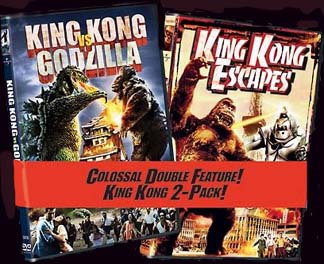 KING
KONG VS. GODZILLA (1962)/KING KONG ESCAPES
(1967) (2-Pack)
KING
KONG VS. GODZILLA (1962)/KING KONG ESCAPES
(1967) (2-Pack)Director: Inoshiro Honda
Universal Home Video
 KING
KONG VS. GODZILLA (1962)/KING KONG ESCAPES
(1967) (2-Pack)
KING
KONG VS. GODZILLA (1962)/KING KONG ESCAPES
(1967) (2-Pack)Peter Jackson’s
forthcoming remake of the 1933 classic KING KONG has already created an enormous
amount of pre-release publicity ranging from mega-millions lottery tickets,
to a plethora of toys and games, to a slew of DVDs of vintage science fiction
films featuring giant gorillas like the recent Warners release of the RKO ape
films, and MGM’s release of the 1961 cult favorite, KONGA. Now…our
friends at Universal (the company behind Jackson’s remake) have unleashed
their own King Kong related properties with a spectacular DVD double feature
set of two of the most popular titles made at Japan’s Toho Company Ltd.
and released in the United States by Universal…KING KONG VS. GODZILLA
and KING KONG ESCAPES. Finally, genre fans can rejoice as we now have these
two cult favorites in their definitive U.S. versions with fine transfers (BOTH
IN WIDESCREEN!!!) and beautiful color.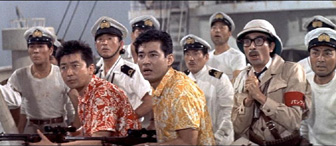
The plot of KING KONG VS. GODZILLA is more or a less a rehash of some of the ideas found in the 1933 KING KONG as Toshio Tako (Ichiro Arishima) searches for a giant monster to bring back to Tokyo to appear on his badly rated television show. Tako sends two of his employees, Kenchiro Sakurai (Tadeo Takashima) and Furue (Yu Fujiki), to Faro Island in the South Seas to bring back the “native god” rumored to be living in the island’s mountain. Of course, this god materializes in the form of a 200 foot-tall gorilla dubbed King Kong (NOT the same King Kong from the 1933 film) by the local natives. Kong’s first action is to battle a huge octopus (in a very impressive special effects scene in which a real octopus was used) and after defeating the water monster, the gorilla proceeds to get drunk on a narcotic-like berry juice drug. The sedated monster is then taken toward Japan on a raft where he escapes and battles the one and only Godzilla. It seems Japan’s favorite reptile has been hibernating in an iceberg (as per the ending of the last film, 1955’s GODZILLA RAIDS AGAIN) until abnormally warm temperatures and the crash of a U.N. submarine release him from his frozen tomb. Eventually, the two behemoths meet and do battle in the amusing and exciting climax after each has caused much carnage and mayhem throughout Japan.
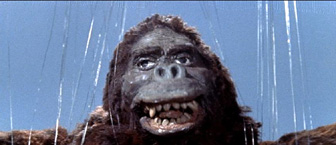
The genesis of what would eventually become KING KONG VS. GODZILLA actually began with the legendary creator of the 1933 KING KONG: Willis H. O’Brien. After many professional disappointments (including RKO’s shelving of the proposed THE WAR EAGLES and GWANGI), O’Brien was hired as “technical advisor” on Irwin Allen’s 1960 remake of THE LOST WORLD. O’Brien had helmed the groundbreaking stop motion effects in the 1925 version of Sir Arthur Conan Doyle’s classic tale of dinosaurs being discovered on a lost plateau in 20th century South America. Much to O’Brien’s chagrin, he discovered Allen wanted to use live lizards disguised as dinosaurs instead of animating dinosaur models. Allen knew from working with O’Brien and Ray Harryhausen on 1956’s ANIMAL WORLD how time consuming stop motion photography was and he did not want THE LOST WORLD to be tied up in a lengthy post-production process. Annoyed and disappointed at the turn of events, O’Brien set off to develop a story that would pit a stop motion King Kong battling an animated Frankenstein’s Monster. “King Kong VS. Frankenstein” was meant to bring back Carl Denham (played by Robert Armstrong in the 1933 film) in a new adventure that would have King Kong and a gigantic version of Mary Shelley’s monster battling in San Francisco. O’Brien took the proposal to independent producer, John Beck and Beck promised to keep O’Brien informed on the development. Time passed and O’Brien read in Variety that Beck made a co-production deal with Japan’s Toho Company Ltd. for KING KONG VS. GODZILLA and that King Kong was going to be portrayed by a stuntman in a gorilla costume. O’Brien was heartbroken over this, and passed away in November 1962 before he could take any legal action.
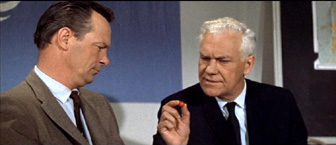 After
shooting was completed in Japan, producer Beck decided that the film was too
Japanese with not enough American elements that symbolized King Kong. He then
hired American actors Michael Keith, Harry Holcombe (FOXY BROWN, EMPIRE OF THE
ANTS) and Japanese/American actor James Yagi (THE MANCHURIAN CANDIDATE) to shoot
new scenes in Hollywood which really add nothing to the story, but rather detract
from it. The Japanese version was basically a light-hearted spoof of the Japanese
corporate world of television, while the American actors play their end so straight
and serious that the film is wildly uneven. Of course, with the addition of
so much new American footage, Japanese scenes were cut, trimmed, or rearranged
to the point where Akira Ifukubie’s terrific musical score became a casualty
of the editor’s cuts. Universal replaced Ifukubie’s score with library
music by Joseph Gershenson and genre fans will immediately recognize the themes
from such classic Universal films as THE CREATURE FROM THE BLACK LAGOON (1954),
FRANKENSTEIN MEETS THE WOLFMAN (1943), and GHOST OF FRANKENSTEIN (1942).
After
shooting was completed in Japan, producer Beck decided that the film was too
Japanese with not enough American elements that symbolized King Kong. He then
hired American actors Michael Keith, Harry Holcombe (FOXY BROWN, EMPIRE OF THE
ANTS) and Japanese/American actor James Yagi (THE MANCHURIAN CANDIDATE) to shoot
new scenes in Hollywood which really add nothing to the story, but rather detract
from it. The Japanese version was basically a light-hearted spoof of the Japanese
corporate world of television, while the American actors play their end so straight
and serious that the film is wildly uneven. Of course, with the addition of
so much new American footage, Japanese scenes were cut, trimmed, or rearranged
to the point where Akira Ifukubie’s terrific musical score became a casualty
of the editor’s cuts. Universal replaced Ifukubie’s score with library
music by Joseph Gershenson and genre fans will immediately recognize the themes
from such classic Universal films as THE CREATURE FROM THE BLACK LAGOON (1954),
FRANKENSTEIN MEETS THE WOLFMAN (1943), and GHOST OF FRANKENSTEIN (1942).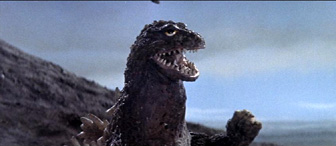 In
June 1963, KING KONG VS. GODZILLA was released in the United States in its American
version and actually did quite well as the box office. In its native Japan,
it was the highest grossing film of the year during its August 1962 release.
Television also played an enormous role in keeping this particular film alive
for all these years. Anyone of this reviewer’s age group (mid 30’s)
who lived in the New York area will remember with great fondness the numerous
showings on WOR-TV (Channel 9…now UPN 9) especially the many years it
aired as part of WOR’s annual Thanksgiving weekend marathon of King Kong
and Godzilla films as well as its frequent showings on WOR’s Million Dollar
Movie.
In
June 1963, KING KONG VS. GODZILLA was released in the United States in its American
version and actually did quite well as the box office. In its native Japan,
it was the highest grossing film of the year during its August 1962 release.
Television also played an enormous role in keeping this particular film alive
for all these years. Anyone of this reviewer’s age group (mid 30’s)
who lived in the New York area will remember with great fondness the numerous
showings on WOR-TV (Channel 9…now UPN 9) especially the many years it
aired as part of WOR’s annual Thanksgiving weekend marathon of King Kong
and Godzilla films as well as its frequent showings on WOR’s Million Dollar
Movie.
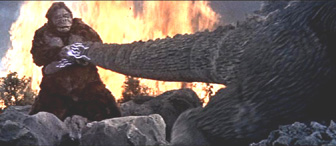 Universal’s
transfer of KING KONG VS. GODZILLA is very well done (although NOT as well done
as the companion feature, KING KONG ESCPAES). This is apparently the remastered
print that was showing at the Godzilla film festival at New York’s Film
Forum in 2004. The colors are vibrant and the picture image is fairly sharp
although part of the problem is probably the fact that Toho’s film stock
was not as good as it became from 1964 and beyond, so when Universal struck
the original negative from Toho in 1963, the Toho film stock was inferior. If
one looks at Toho’s earlier films (THE MYSTERIANS, VARAN THE UNBELIEVABLE
or even the original GODZILLA), there is always a somewhat grainy look to them.
By the time ATTACK OF THE MUSHROOM PEOPLE was made in 1963, there was a definite
improvement in picture quality. This was corrected 100% by the time Universal
co-produced KING KONG ESCPAES in 1967. However, this DVD is presented in anamorphic
widescreen (2.35:1 Tohoscope) so now all genre fans can go to their DVD shelves
and take that terrible and grainy old 1998 Goodtimes DVD and mercifully throw
it out the window, as we now have the DEFINITIVE DVD of KING KONG VS. GODZILLA.
Even this new DVD cover is an improvement over the silly Goodtimes cover art
that featured images of the Dino De Laurentiis Kong superimposed with a picture
of the GODZILLA 1985 costume. The audio is crisp and clear and is available
in English only with subtitles available in English, French or Spanish.
Universal’s
transfer of KING KONG VS. GODZILLA is very well done (although NOT as well done
as the companion feature, KING KONG ESCPAES). This is apparently the remastered
print that was showing at the Godzilla film festival at New York’s Film
Forum in 2004. The colors are vibrant and the picture image is fairly sharp
although part of the problem is probably the fact that Toho’s film stock
was not as good as it became from 1964 and beyond, so when Universal struck
the original negative from Toho in 1963, the Toho film stock was inferior. If
one looks at Toho’s earlier films (THE MYSTERIANS, VARAN THE UNBELIEVABLE
or even the original GODZILLA), there is always a somewhat grainy look to them.
By the time ATTACK OF THE MUSHROOM PEOPLE was made in 1963, there was a definite
improvement in picture quality. This was corrected 100% by the time Universal
co-produced KING KONG ESCPAES in 1967. However, this DVD is presented in anamorphic
widescreen (2.35:1 Tohoscope) so now all genre fans can go to their DVD shelves
and take that terrible and grainy old 1998 Goodtimes DVD and mercifully throw
it out the window, as we now have the DEFINITIVE DVD of KING KONG VS. GODZILLA.
Even this new DVD cover is an improvement over the silly Goodtimes cover art
that featured images of the Dino De Laurentiis Kong superimposed with a picture
of the GODZILLA 1985 costume. The audio is crisp and clear and is available
in English only with subtitles available in English, French or Spanish.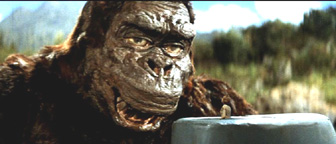 KING
KONG ESCAPES was a 1967 co-production between Toho/Universal/Rankin-Bass Productions.
By this time, the name Rankin-Bass was firmly associated with animated puppet
holiday specials like RUDOLPH, THE RED-NOSED REINDEER (1964) and feature films
like MAD MONSTER PARTY? (1966). In September, 1966, ABC-TV began airing Rankin-Bass’
animated cartoon series “King Kong” as part of their Saturday morning
lineup. The cartoon tells of the adventures of Professor Bond and his children,
Bobby and Susan, and their discovery of King Kong on the far away Mondo Island.
Kong becomes something of a pet to young Bobby Bond and protects the family
from a variety of monsters and evil villains (most notably Dr. Who and his assortment
of fiendish creations including a giant King Kong robot replica, Mechani-Kong).
KING
KONG ESCAPES was a 1967 co-production between Toho/Universal/Rankin-Bass Productions.
By this time, the name Rankin-Bass was firmly associated with animated puppet
holiday specials like RUDOLPH, THE RED-NOSED REINDEER (1964) and feature films
like MAD MONSTER PARTY? (1966). In September, 1966, ABC-TV began airing Rankin-Bass’
animated cartoon series “King Kong” as part of their Saturday morning
lineup. The cartoon tells of the adventures of Professor Bond and his children,
Bobby and Susan, and their discovery of King Kong on the far away Mondo Island.
Kong becomes something of a pet to young Bobby Bond and protects the family
from a variety of monsters and evil villains (most notably Dr. Who and his assortment
of fiendish creations including a giant King Kong robot replica, Mechani-Kong).
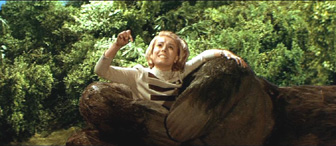
In 1966, Rankin Bass contracted with Toho to produce a live-action version of the cartoon series originally titled OPERATION ROBINSON CRUSOE. After seeing that the script did not have enough elements to make a clear tie-in to the cartoon series, Rankin-Bass rejected it, but Toho made some changes and substituted Godzilla for King Kong and the film was made as GODZILLA VS. THE SEA MONSTER (1966). A few months later, Rankin-Bass accepted a script that came closer to capturing the heart of the television show. This was known as KING KONG’S COUNTERATTACK (or KING KONG ESCAPES in the United States). Script elements included Mondo Island, Dr. Who, and Mechani-Kong, as well as leading characters somewhat resembling the Bond family from the cartoon.
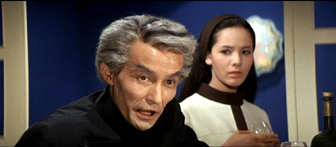 In
the far reaches of the North Pole, evil genius Dr. Who (played with hammy gleefulness
by Japanese actor Eisei Amamoto and voiced in the U.S. version by the legendary
voice actor Paul Frees) and his mysterious benefactress from an unnamed Communist
government, Madame X (Mie Hama) plan to extract the powerful “Element
X” in an effort to build up Madame X’s nuclear arsenal beyond the
United States and the Soviet Union. This goal for world domination is about
to be realized by Mechani-Kong, a huge robot replica of the legendary King Kong.
On a first test, Mechani-Kong short-circuits due to the high intensity of radioactivity
from Element X and Dr. Who journeys to Mondo Island to kidnap the real King
Kong to do the digging for him.
In
the far reaches of the North Pole, evil genius Dr. Who (played with hammy gleefulness
by Japanese actor Eisei Amamoto and voiced in the U.S. version by the legendary
voice actor Paul Frees) and his mysterious benefactress from an unnamed Communist
government, Madame X (Mie Hama) plan to extract the powerful “Element
X” in an effort to build up Madame X’s nuclear arsenal beyond the
United States and the Soviet Union. This goal for world domination is about
to be realized by Mechani-Kong, a huge robot replica of the legendary King Kong.
On a first test, Mechani-Kong short-circuits due to the high intensity of radioactivity
from Element X and Dr. Who journeys to Mondo Island to kidnap the real King
Kong to do the digging for him.
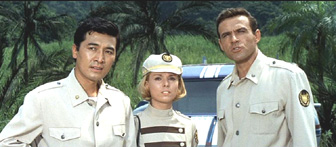 On
another front, U.N. submarine Explorer commanded by Carl Nelson (Rhodes Reason)
with a Japanese and American crew including Lt. Jiro Nimura (Akira Takarada)
and nurse Lt. Susan Watson (Linda Miller) makes land fall on Mondo Island and
are about to be eaten by a huge dinosaur (later, this costume was re-used in
other Toho films and the creature christened, Gorosaurus) when none other than
King Kong appears and cuts the creature down to size (this scene is an homage
to the Tyrannosaurus Rex sequence in the 1933 original). Of course, Kong being
Kong falls in love with pretty Lt. Watson and becomes her guardian and protector.
Eventually, Kong and his robot counterpart do battle atop the impressive Tokyo
Tower (substituting for the Empire State Building) that leads to an explosive
climax.
On
another front, U.N. submarine Explorer commanded by Carl Nelson (Rhodes Reason)
with a Japanese and American crew including Lt. Jiro Nimura (Akira Takarada)
and nurse Lt. Susan Watson (Linda Miller) makes land fall on Mondo Island and
are about to be eaten by a huge dinosaur (later, this costume was re-used in
other Toho films and the creature christened, Gorosaurus) when none other than
King Kong appears and cuts the creature down to size (this scene is an homage
to the Tyrannosaurus Rex sequence in the 1933 original). Of course, Kong being
Kong falls in love with pretty Lt. Watson and becomes her guardian and protector.
Eventually, Kong and his robot counterpart do battle atop the impressive Tokyo
Tower (substituting for the Empire State Building) that leads to an explosive
climax.
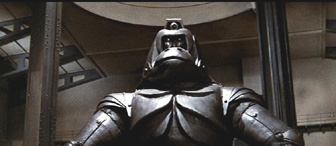 KING
KONG ESCAPES has long been a favorite of “kaiju” (monster) film
fans and with good reason. It is a fast paced 97 minutes done in the style of
old comic books or serials of the 1930s with villains dressed in black with
goals of world domination while the virtuous good guys come through in the end.
Also apparent is the influence of the James Bond films of that era. Perhaps
then it was no coincidence that this was Mie Hama’s first film role after
returning to Japan from England where she played Bond girl Kissy Suzuki in 1967’s
YOU ONLY LIVE TWICE co-starring Sean Connery. In addition, Dr. Who’s arctic
laboratory could have been used by any of the Bond villains (Dr. No, Goldfinger,
Blofeld). Eisei Amamoto’s over-the-top performance as Dr. Who also gives
KING KONG ESCAPES the flavor of a James Bond film.
KING
KONG ESCAPES has long been a favorite of “kaiju” (monster) film
fans and with good reason. It is a fast paced 97 minutes done in the style of
old comic books or serials of the 1930s with villains dressed in black with
goals of world domination while the virtuous good guys come through in the end.
Also apparent is the influence of the James Bond films of that era. Perhaps
then it was no coincidence that this was Mie Hama’s first film role after
returning to Japan from England where she played Bond girl Kissy Suzuki in 1967’s
YOU ONLY LIVE TWICE co-starring Sean Connery. In addition, Dr. Who’s arctic
laboratory could have been used by any of the Bond villains (Dr. No, Goldfinger,
Blofeld). Eisei Amamoto’s over-the-top performance as Dr. Who also gives
KING KONG ESCAPES the flavor of a James Bond film.
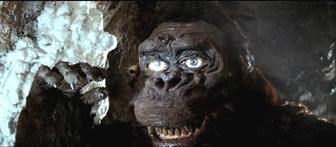 Universal’s
transfer of KING KONG ESCAPES is terrific. The remastered print is pristine
as they come and this is especially true during the Mondo Island scenes. The
foliage is a vivid green with a deep blue sky in the background. Also, in many
prints of this film, the night scenes in Tokyo have often been too dark to make
out the battle on the Tokyo Tower. This has been corrected beautifully in this
transfer. The English audio is crisp and clear and subtitles are optional in
English, French or Spanish. Like KING KONG VS. GODZILLA, KING KONG ESCAPES is
presented in anamorphic Tohoscope (2.35:1). The only downside is that no extras
are included.
Universal’s
transfer of KING KONG ESCAPES is terrific. The remastered print is pristine
as they come and this is especially true during the Mondo Island scenes. The
foliage is a vivid green with a deep blue sky in the background. Also, in many
prints of this film, the night scenes in Tokyo have often been too dark to make
out the battle on the Tokyo Tower. This has been corrected beautifully in this
transfer. The English audio is crisp and clear and subtitles are optional in
English, French or Spanish. Like KING KONG VS. GODZILLA, KING KONG ESCAPES is
presented in anamorphic Tohoscope (2.35:1). The only downside is that no extras
are included.
All die-hard Toho monster movie fans will want these classics in their collections as they are at a very reasonable price and in all their widescreen and remastered glory. Let us see now if Peter Jackson’s remake of the venerable classic will live up to the hype or will if plunge like Kong did off the Empire State Building. (Joe Cascio)